CME to spark solar storm on Mars and erode its atmosphere, reveals NASA model; Check details
NASA models have detected a full halo CME moving towards Mars for a direct hit. It is expected to trigger a solar storm, eroding a small amount of its atmosphere. Know all about it.

The unrelenting solar activity on the Sun is not just affecting the Earth but all the nearby planets as well. In October, it was reported that an intense coronal mass ejection (CME) cloud hit Venus and the strong electromagnetic fluctuation resulted in eroding some of its atmosphere which released into space. Now, a full halo CME is set to hit Mars and trigger a solar storm on December 11, as per data from a NASA model. It too will have a similar effect on the red planet and it is expected to disintegrate a small amount of its atmosphere. Interestingly, the CME can also spark an aurora display on Mars.
According to a report by SpaceWeather.com, “Earlier today, a full halo CME left the sun. Analysts believe it will miss Earth. Instead, it is heading for Mars. NASA models suggest a direct hit on Dec. 11th. The impact will probably spark ultraviolet auroras and erode a small amount of the Red Planet's atmosphere”.
Solar storm to strike Mars, erode its atmosphere
The Earth has lucked out this time. The particular CME is a full halo CME, considered to be the strongest of its kind, containing massive amounts of electromagnetic energy. Had it struck the Earth, we might have seen a moderate to strong solar storm, much stronger than any we have seen in 2023.
But this also gives space weather researchers a chance to observe the effect of a powerful solar storm event and how it affects Mars. The report suggests that ultraviolet auroras are possible on Mars and NASA's vehicles such as Ingenuity and the Mars rover will observe the event and collect data to see how it impacts a planet with a much thinner atmosphere compared to our planet.
This does not mean the Earth is safe this week. Yesterday NASA models highlighted the possibility of a minor solar storm event tomorrow, December 9, as a result of a CME released from a sigmoid eruption on the Sun. It can spark auroras in the higher latitudes, and can impact short-wave radio propagation in the geoeffective areas.
The role of the NASA Solar Dynamics Observatory
The NASA Solar Dynamics Observatory (SDO) carries a full suite of instruments to observe the Sun and has been doing so since 2010. It uses three very crucial instruments to collect data from various solar activities. They include the Helioseismic and Magnetic Imager (HMI) which takes high-resolution measurements of the longitudinal and vector magnetic field over the entire visible solar disk, Extreme Ultraviolet Variability Experiment (EVE) which measures the Sun's extreme ultraviolet irradiance, and Atmospheric Imaging Assembly (AIA) which provides continuous full-disk observations of the solar chromosphere and corona in seven extreme ultraviolet (EUV) channels.
Catch all the Latest Tech News, Mobile News, Laptop News, Gaming news, Wearables News , How To News, also keep up with us on Whatsapp channel,Twitter, Facebook, Google News, and Instagram. For our latest videos, subscribe to our YouTube channel.





























